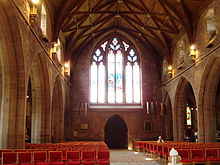TheCathedral Church of Saints Asaph and Cyndeyrn,commonly calledSt Asaph Cathedral(Welsh:Eglwys Gadeiriol Llanelwy), is acathedralinSt Asaph,Denbighshire,northWales.It is theepiscopal seatof theBishop of St Asaph.The cathedral dates back 1,400 years, while the current building dates from the 13th century.[1]The cathedral is part of theChurch in Walesand part of theAnglican Communionof Wales.
| Saint Asaph Cathedral | |
|---|---|
| Cathedral Church of Saints Asaph and Cyndeyrn | |
Eglwys Gadeiriol Llanelwy | |
 St Asaph Cathedral from the north-west | |
 | |
| 53°15′26″N3°26′31″W/ 53.25722°N 3.44194°W | |
| Location | St Asaph,Denbighshire |
| Country | Wales |
| Denomination | Church in Wales |
| Previous denomination | Roman Catholic Church of England |
| Website | https://stasaphcathedral.wales/en |
| History | |
| Relicsheld | St Asaph |
| Architecture | |
| Style | Romanesque architecture,English Gothic architecture |
| Completed | Mid-13th century |
| Administration | |
| Diocese | St Asaph |


History
editA church was originally built on or near the site bySaint Kentigernin the 6th century (other sources say Saint Elwy in 560).Saint Asa (or Asaph),a grandson ofPabo Post Prydain,followed after this date.
The earliest parts of the present building date from the 13th century when a new building was begun on the site after the original stone cathedral was burnt by soldiers ofKing Edward Iduring the Second Welsh War in 1282. Indeed, there had been plans, following the First Welsh War (1277) to relocate the church toRhuddlan,plans supported byBishop Anian(Einion I). However these plans came to nought following the war of 1282, asConwyandCaernarfonwere considered to be the new centres of administration.[2]
The rebellion ofOwain Glyndŵrresulted in part of the cathedral being reduced to a ruin for seventy years. The present building was largely built in the reign ofHenry Tudorand greatlyrestoredin the 19th century.
The cathedral made the national press in 1930 when the tower became subject to significantsubsidenceand the cathedral architectCharles Marriott Oldrid Scottadvised of urgent repairs to be undertaken.[3][4]It was reported that the cause of the damage was by a subterranean stream.[5]It made the papers again when work was approaching completion in 1935.[6]
Geoffrey of Monmouthserved asBishop of St Asaphfrom 1152 to 1155, although due to war and unrest in Wales at the time, he probably never set foot in his see.William Morgan(1545 – 10 September 1604) was also Bishop of St Asaph and ofLlandaff,and was the first to translate the whole Bible, from Greek and Hebrew, into Welsh. His Bible is kept on public display in the cathedral. The first Archbishop of WalesA. G. Edwardswas appointed Bishop of St Asaph in 1889.
In August 2018, the cathedral took the controversial step of making its music staff redundant, citing financial pressures.[7]The cathedral have since reestablished the position of Director of music following the appointment of Paul Booth from September 2019. The choir continue to sing for three services a week.
The organ
editA specification of the organ can be found on the National Pipe Organ Register.[8]
List of organists
edit| Year instated | Name |
|---|---|
| 1620 | John Day |
| 1630 | Abednego D. Perkins |
| 1631 | John Wilson |
| 1669 | Thomas Ottey |
| 1680 | William Key |
| 1686 | Thomas Hughes |
| 1694 | Alexander Gerard |
| 1738 | John Gerard |
| 1782 | John Jones |
| 1785 | Edward Bailey |
| 1791 | Charles Spence |
| 1794 | Henry Hayden |
| 1834 | Robert Augustus Atkins |
| 1889 | Llewellyn Lloyd |
| 1897 | Hugh Percy Allen |
| 1898 | Archibald Wayet Wilson |
| 1901 | Cyril Bradley Rootham |
| 1902 | William Edward Belcher |
| 1917 | Harold Carpenter Lumb Stocks |
| 1956 | Robert Duke Dickinson |
| 1962 | James Roland Middleton |
| 1970 | Graham John Elliott |
| 1981 | John Theodore Belcher |
| 1985 | Hugh Davies |
| 1998 | Graham Eccles |
| 2004 | Alan McGuinness |
| 2018 | position abolished[7] |
| 2019 | Paul Booth - position reestablished |
Assistant organists
edit- Llewelyn Lloyd 1875–1889 (later organist)
- F. Walton Evans 1897–1901
Assistant Director of Music
edit- John Hosking (2004–2018)
Burials
edit- John Owen (bishop of St Asaph),Bishop of St Asaph(1629 to 1651)
- Isaac Barrow (bishop),Bishop of St Asaph (1669–1680)—buried in the Cathedral churchyard
- William Mathias(1934–1992), composer, born inWhitland,Carmarthenshire.
- William Carey (bishop),Bishop of St Asaph (1830–1846)—buried in the Cathedral churchyard
- Joshua Hughes,Bishop of St Asaph (1870–1889)
- A. G. Edwards,Bishop of St Asaph (1889–1934) and firstArchbishop of Wales
See also
edit- List of deans of St Asaph—chronological list
References
edit- ^"St Asaph in north Wales named Diamond Jubilee city".BBC News.14 March 2012.
- ^A.J. Taylor, ‘Rhuddlan cathedral: a ‘might-have-been’ of Flintshire history’, Flintshire Historical Society Publications 15 (1954-5)
- ^The Times,Saturday April 5, 1930; pg. 11; Issue 45480; col E
- ^The Times,Saturday April 19, 1930; pg. 12; Issue 45491; col B.
- ^The Times,Saturday September 6, 1930; pg. 12; Issue 45611; col D
- ^The Times,Wednesday September 18, 1935; pg. 13; Issue 47172; col E
- ^ab"Cathedral makes music team redundant".BBC News.27 August 2018.Retrieved19 September2018.
- ^"The National Pipe Organ Register - NPOR".
- ^"Assistant Director of Music".Archived fromthe originalon 30 April 2018.
Further reading
editExternal links
editMedia related toSt Asaph Cathedralat Wikimedia Commons